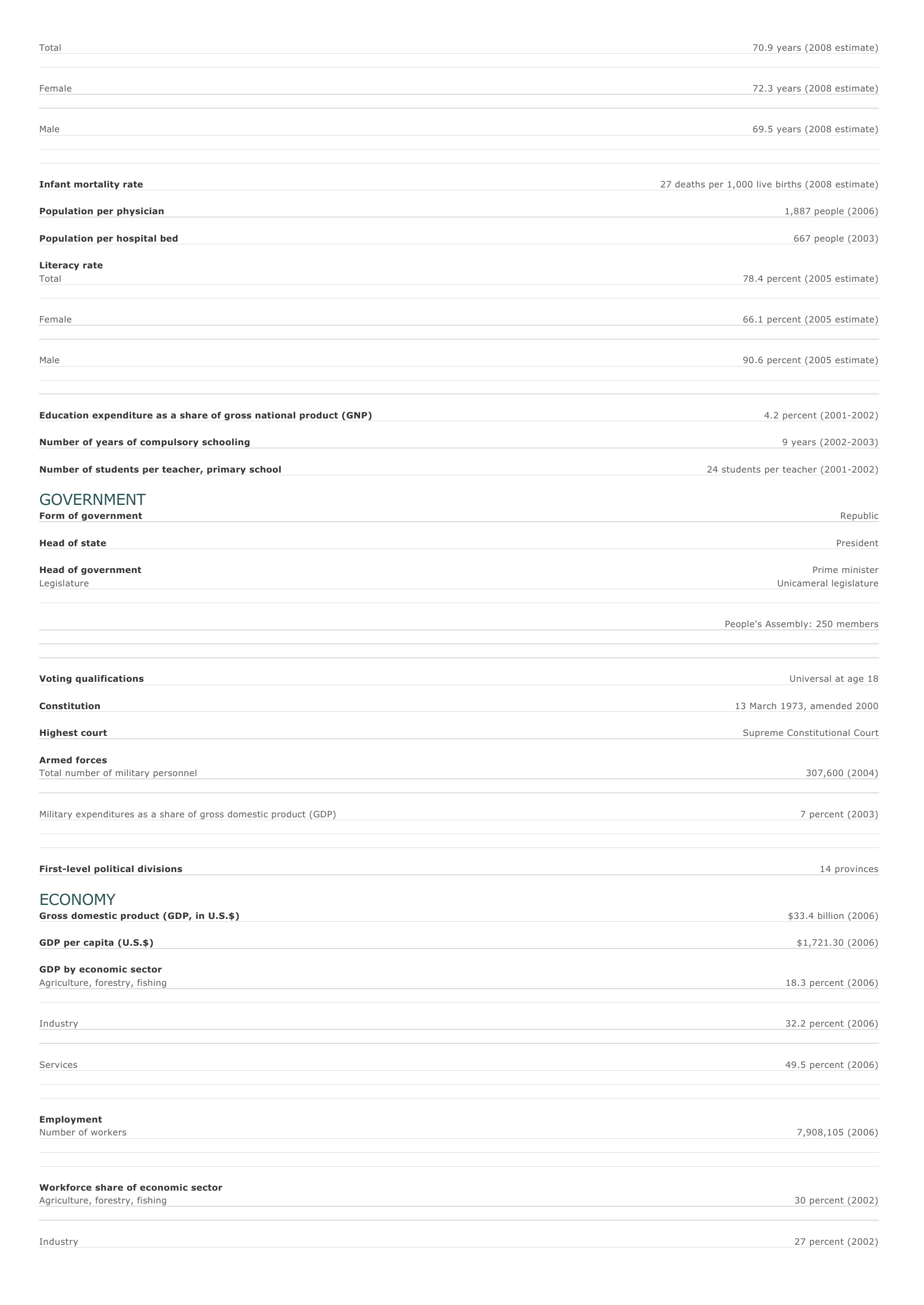Syria Facts and Figures. BASIC FACTS Official name Capital Area Syrian Arab Republic Damascus 185,180 sq km 71,498 sq mi PEOPLE Population 19,747,586 (2008 estimate) Population growth Population growth rate 2.19 percent (2008 estimate) Projected population in 2025 26,547,725 (2025 estimate) Projected population in 2050 34,437,235 (2050 estimate) Population density 107 persons per sq km (2008 estimate) 278 persons per sq mi (2008 estimate) Urban/rural distribution Share urban 50 percent (2005 estimate) Share rural 50 percent (2005 estimate) Largest cities, with population Damascus 2,228,000 (2003 estimate) ?alab 3,970,000 (2004 estimate) ?im ? 1,577,000 (2004 estimate) Al L?dhiq?yah 311,784 (1994) ?am? h 264,348 (1994) Ethnic groups Arab 90 percent Kurd, Armenian, Turkmen, Circassian, Assyrian, Palestinian 10 percent Languages Arabic (official), Kurdish, Armenian, Aramaic, Circassian; French widely understood Religious affiliations Sunni Muslim 73 percent Ismailis, Shiites, Alawite and other Muslim factions 13 percent Christian 10 percent Druze 3 percent Other (including tiny Jewish communities in Damascus, Al Q? mishl?, and ?alab) 1 percent HEALTH AND EDUCATION Life expectancy Total 70.9 years (2008 estimate) Female 72.3 years (2008 estimate) Male 69.5 years (2008 estimate) Infant mortality rate Population per physician Population per hospital bed 27 deaths per 1,000 live births (2008 estimate) 1,887 people (2006) 667 people (2003) Literacy rate Total 78.4 percent (2005 estimate) Female 66.1 percent (2005 estimate) Male 90.6 percent (2005 estimate) Education expenditure as a share of gross national product (GNP) Number of years of compulsory schooling Number of students per teacher, primary school 4.2 percent (2001-2002) 9 years (2002-2003) 24 students per teacher (2001-2002) GOVERNMENT Form of government Head of state Head of government Legislature Republic President Prime minister Unicameral legislature People's Assembly: 250 members Voting qualifications Constitution Highest court Universal at age 18 13 March 1973, amended 2000 Supreme Constitutional Court Armed forces Total number of military personnel Military expenditures as a share of gross domestic product (GDP) First-level political divisions 307,600 (2004) 7 percent (2003) 14 provinces ECONOMY Gross domestic product (GDP, in U.S.$) GDP per capita (U.S.$) $33.4 billion (2006) $1,721.30 (2006) GDP by economic sector Agriculture, forestry, fishing 18.3 percent (2006) I ndustry 32.2 percent (2006) Services 49.5 percent (2006) Employment Number of workers 7,908,105 (2006) Workforce share of economic sector Agriculture, forestry, fishing 30 percent (2002) I ndustry 27 percent (2002) Services Unemployment rate 43 percent (2002) 12.3 percent (2003) National budget (U.S.$) Total revenue $17,470 million (1999) Total expenditure $17,470 million (1999) Monetary unit 1 Syrian pound (£S), consisting of 100 piastres Major trade partners for exports Germany, Italy, United Arab Emirates, France, and Turkey Major trade partners for imports Italy, Germany, France, South Korea, and Turkey ENERGY, COMMUNICATIONS, AND TRANSPORTATION Electricity production Electricity from thermal sources 59 percent (2003 estimate) Electricity from hydroelectric sources 41 percent (2003 estimate) Electricity from nuclear sources 0 percent (2003 estimate) Electricity from geothermal, solar, and wind sources 0 percent (2003 estimate) Number of radios per 1,000 people 278 (1997) Number of telephones per 1,000 people 152 (2005) Number of televisions per 1,000 people 61 (2000 estimate) Number of Internet hosts per 10,000 people 0.01 (2003) Daily newspaper circulation per 1,000 people 20 (1996) Number of motor vehicles per 1,000 people 36 (2004) Paved road as a share of total roads 14 percent (2002) SOURCES Basic Facts and People sections Area data are from the statistical bureaus of individual countries. Population, population growth rate, and population projections are from the United States Census Bureau, International Programs Center, International Data Base (IDB) (www.census.gov). Urban and rural population data are from the Food and Agriculture Organization (FAO) of the United Nations (UN), FAOSTAT database (www.fao.org). Largest cities population data and political divisions data are from the statistical bureaus of individual countries. Ethnic divisions and religion data are largely from the latest Central Intelligence Agency (CIA) World Factbook and from various country censuses and reports. Language data are largely from the Ethnologue, Languages of the World, Summer Institute of Linguistics International (www.sil.org). Health and Education section Life expectancy and infant mortality data are from the United States Census Bureau, International Programs Center, International database (IDB) (www.census.gov). Population per physician and population per hospital bed data are from the World Health Organization (WHO) (www.who.int). Education data are from the United Nations Educational, Scientific and Cultural Organization (UNESCO) database (www.unesco.org). Government section Government, independence, legislature, constitution, highest court, and voting qualifications data are largely from various government Web sites, the latest Europa World Yearbook, and the latest Central Intelligence Agency (CIA) World Factbook. The armed forces data is from Military Balance. Economy section Gross domestic product (GDP), GDP per capita, GDP by economic sectors, employment, and national budget data are from the World Bank database (www.worldbank.org). Monetary unit, agriculture, mining, manufacturing, exports, imports, and major trade partner information is from the statistical bureaus of individual countries, latest Europa World Yearbook, and various United Nations and International Monetary Fund (IMF) publications. Energy, Communication, and Transportation section Electricity information is from the Energy Information Administration (EIA) database (www.eia.doe.gov). Radio, telephone, television, and newspaper information is from the United Nations Educational, Scientific and Cultural Organization (UNESCO) database (www.unesco.org). Internet hosts, motor vehicles, and road data are from the World Bank database (www.worldbank.org). Note Figures may not total 100 percent due to rounding. Microsoft ® Encarta ® 2009. © 1993-2008 Microsoft Corporation. All rights reserved.



